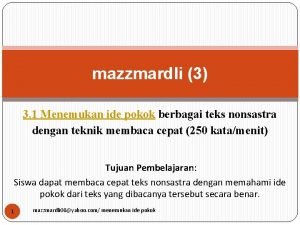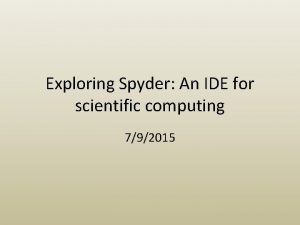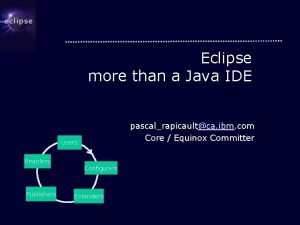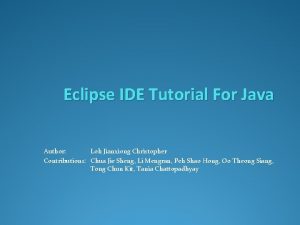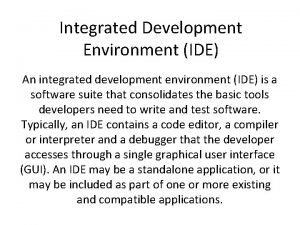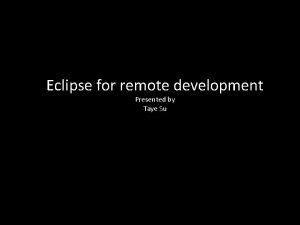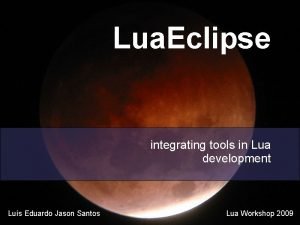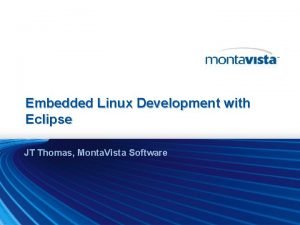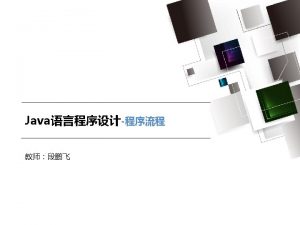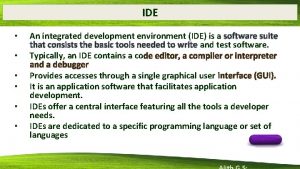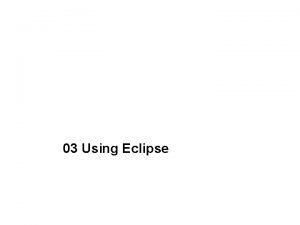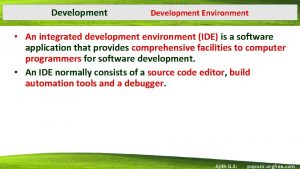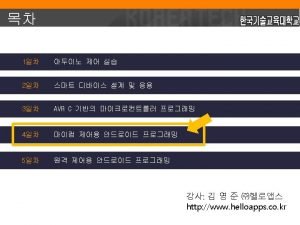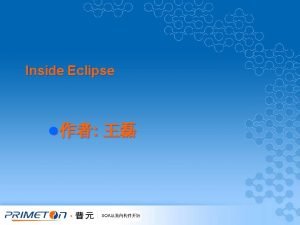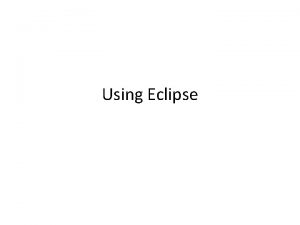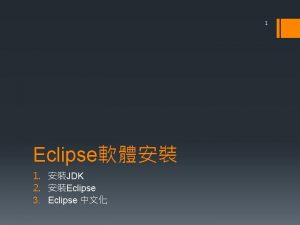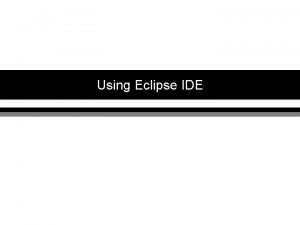ECLIPSE KEVIN DANIELS OVERVIEW Integrated Development Environment IDE

















- Slides: 17

ECLIPSE KEVIN DANIELS

OVERVIEW • Integrated Development Environment (IDE) • Usually used to develop applications in various programming languages (C, C++. Java, Java. Script, Perl, Python, etc. ) • Also used for Android Development and PHP Development

USES FOR KERNEL DEVELOPMENT • Using Eclipse CDT (C/C++ Development Tooling) • • • Code editor with syntax highlighting Visual debugging tools Details about errors/warnings Standard make build Setting/changing build commands/directories Disable automatic building (every time you change something it doesn’t require you to rebuild the whole kernel) • And more!

SETTING UP ECLIPSE • Download Eclipse CDT from www. eclipse. org/cdt • Eclipse requires Java (install Java) • Extract and then ‘cd’ to containing directory and type: . /eclipse • Create new C Project, uncheck the “Use default work space” and select it to the location of your kernel’s directory • Go to Window -> Preferences -> General -> Workspace -> and disable option “Build automatically”

TURNING OFF AUTO BUILD

INDEXING IN ECLIPSE • Indexing makes navigating through your code much more efficient and helps you and Eclipse interpret code correctly. • Cons: • Usually does not work out of the box for large projects like Linux kernels. • It can be very tedious to configure all the correct paths for Eclipse to look through for header files and other includes. • Once set up it can still take some time for Eclipse to locate everything and be in sync. • Changing certain headers can not only lead to lengthy rebuilds of the project, but indexing as well.

ADDING A PATH FOR INDEXING • • • Click on the Project folder Go to Project -> Properties -> C/C++ General -> Preprocessor Include Paths, Macros. . . Under Languages click GNU C, then select CDT User Settings Entries then Add… Left dropdown: Preprocessor Macros File Right dropdown: Project Path Put the path in the File text field

REMOVING INDEXING • A lot easier…

SETTING UP THE KERNEL FOR ECLIPSE

BASIC USAGE • Project Explorer: Helps you navigate the kernel/project and select files

BASIC USAGE • Console: Displays output, just like it would in terminal • Problems: shows errors, warnings, and info with their location and allows for sorting

BASIC USAGE • How to build your kernel: Right click project folder, select Build

DEMO – DEBUGGING A KERNEL • Build kernel in Eclipse • Use emulator to run kernel (QEMU – open source emulator that can book Linux kernel directly) • Set up debug configurations (see next slide) • Launch kernel with QEMU: qemu-system-x 86_64 -nokvm -s -S -kernel /home/kevin/downloads/linux 3. 14. 5/arch/x 86/boot/bz. Image • -S stops the kernel at startup • -s is shorthand for -gdb tcp: : 1234 (see next slide)

DEBUG CONFIGURATIONS

DEBUG CONFIGURATIONS (TYPED) • Right click the Project folder, select Debug As… then Debug Configurations • Double Click on “C/C++ Attach to Application” • Browse to the vmlinux in the Application field • Click on Debugger tab, select gdbserver on the top dropdown • Click the Connections tab, select TCP for Type

DEBUGGING • Click the button and select your configuration • After the debugger loads, press F 6 to step through the kernel or F 8 to run it without breaks

RESOURCES • http: //www. eclipse. org/cdt/ • http: //eclipsebook. in/c-cpp-development/tweaking-cdt/ccpp-indexing/ • http: //www. sw-at. com/blog/2011/02/11/linux-kerneldevelopment-and-debugging-using-eclipse-cdt/ • http: //wiki. eclipse. org/How. To_use_the_CDT_to_navigate _Linux_kernel_source • http: //www. opensourceforu. com/2011/02/kerneldevelopment-debugging-using-eclipse/
 Pengorganisasian dan revisi pesan bisnis
Pengorganisasian dan revisi pesan bisnis Bacakan hasilnya di depan guru dan teman-temanmu
Bacakan hasilnya di depan guru dan teman-temanmu Python ide for scientific computing
Python ide for scientific computing Eclipse websphere plugin
Eclipse websphere plugin Eclipse ide
Eclipse ide Differentiate between lunar eclipse and solar eclipse
Differentiate between lunar eclipse and solar eclipse Solar lunar eclipse
Solar lunar eclipse What is an ide
What is an ide Arduino integrated development environment
Arduino integrated development environment Overview of integrated marketing communications
Overview of integrated marketing communications Overview of business environment
Overview of business environment Eclipse rcp development
Eclipse rcp development Dev taye
Dev taye Lua development tools
Lua development tools Embedded linux development using eclipse
Embedded linux development using eclipse Procurement integrated enterprise environment
Procurement integrated enterprise environment Integrated award environment
Integrated award environment Financial environment in business environment
Financial environment in business environment

